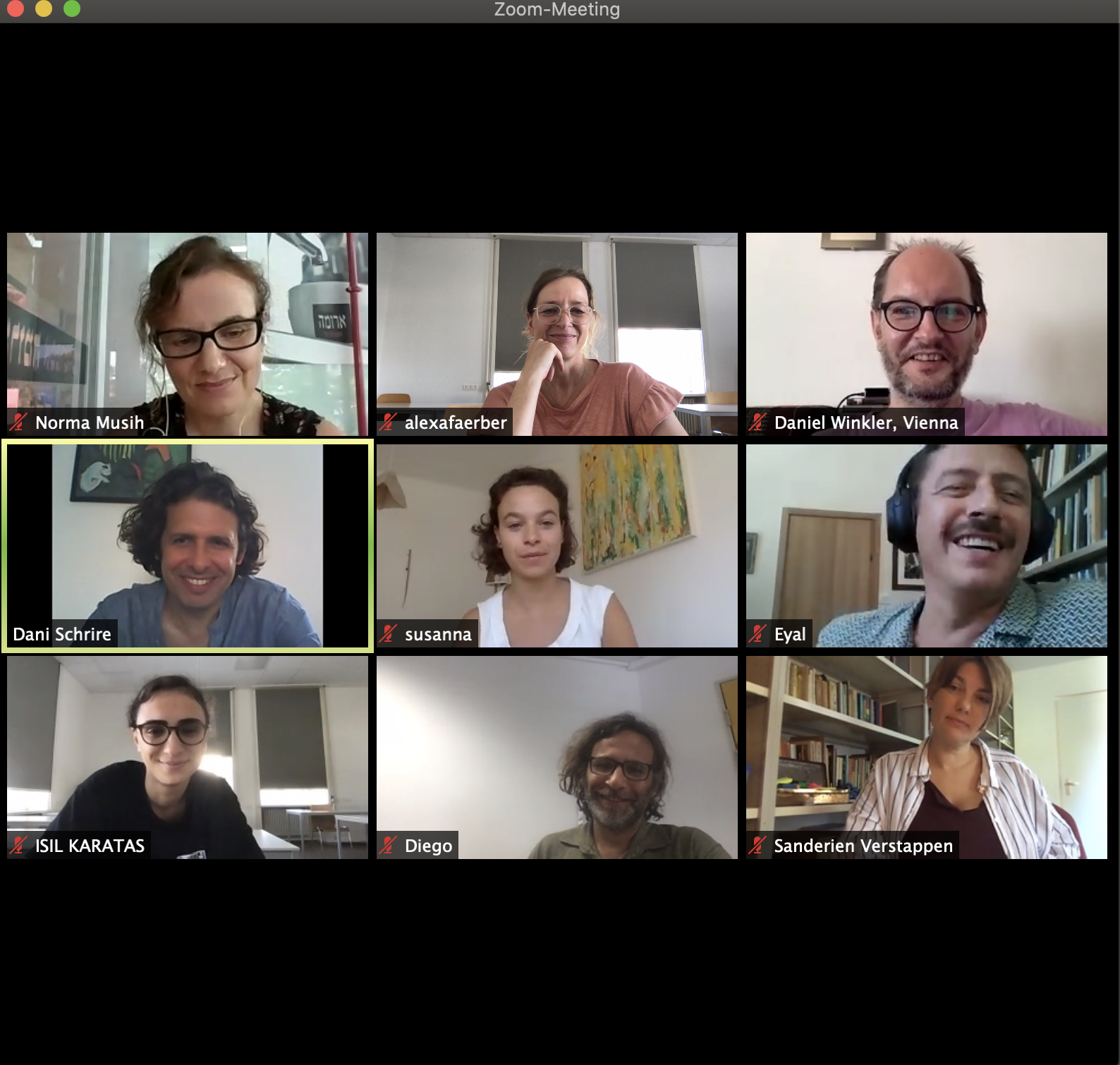The first meeting in preparation of the joint workshop „Living Together in photography, film and text: Promises of the Future and Imaginations of the Past“ supported by Hebrew University Jerusalem and the University of Vienna.

Our fields of research span from „imaginals“ of activist projects in Palestine-Israel, participatory filmmaking in rurban India, cinematic urban imaginary in Marseille and Naples, imaginations of social housing in Vienna to representations of relationships between Jews, Muslims and others in Egyptian TV production. Departing from these individual research interests we will ask in the workshop how both tensions – between different existences and between different temporalities – are articulated within the form of promise and what kind of futures are made graspable in these contemporary and historic imaginations of togetherness.
Participants: Susanna Azevedo, Eyal Sagui Bizawe, Işıl Karataş, Norma Musih, Diego Rotman, Sanderien Verstappen, Daniel Winkler
Speaker: Dani Schrire (HUJ) and Alexa Färber (UV)

Filip de Bock and Sammy Baloji have published „Suturing the city: Living together in Kongo’s Urban Worlds“. Together with Laura Kemmer and AbdouMaliq Simone I have talked about the promises and modes of standing by (the promises) in a talkingphotobooks-session. Quite some promises of the future, I will have another look to find the related imaginations of the past.
https://www.talkingphotobooks.net/standingbykinshasa
Here are the references that appear in our short project paper:
Simone Abram/Gisa Weszkalnys (eds.) (2013): Elusive promises. Planninng in the contemporary world.
Arnold Bartetzky/Mark Schalenberg (eds.) (2011): Urban planning and the pursuit of happiness.
Alexa Färber (2019): „How does ANT help us to rethink the city and its promises?“ In: Anders Blok / Ignacio Farías / Celia Roberts. (eds.): The Routledge Companion to Actor-network Theory. London: Routledge. 264-272.
Let’s add references here
In this project, through the analysis of literary works, photographs, art projects, and activist’s engagements I am interested in developing a theoretical platform for unlearning the past, searching for potential histories, and visualizing alternatives for the future. I argue for the need to „train the imagination to go visiting“, and the urgency of developing new forms of political imagination for Israel/Palestine.
I approach to „living together“ from a technological point of view. Which technologies are allowed to exist (together) and how are promises attributed to new technologies shaping our (audio-visual) cultures and imaginations? What kind of representations of past and future are recording technologies allowing us? My aim with this project is to think beyond dichotomies such as analog and digital, old and new, and towards to concepts of multiplicity. These questions could be asked about production, preservation (archives) and exhibition both from a user/maker’s and viewer’s perspective. An example of multimedia pops in my mind: https://zkm.de/en/media/video/aldo-tambellini-black-matters?fbclid=IwAR0O5ax-bBiL0Z1GuyjS6RkjPgF1ZDta6vzHdePUW5akGdfAeF_bjMGmtQY
I have conducted long-term anthropological research in a rural region in western India that is undergoing rapid urbanisation. I have particularly worked in the expanding peri-urban outskirts of a rapidly growing small town, where I have observed various kinds of legal, spatial, social-economic, and imaginative processes of rural-urban migration and rural-urban land conversion. Here, imaginations of „living together“ in the present/past have become linked with regionally produced imaginations of urban/rural, safety/risk, and mobility/segregation.
For this joint project, my entry question would be when and how the sharing of knowledge about promising futures or significant pasts becomes important to people? Experiences of migration, displacement, violence or segregation could be possible frameworks in which the topic of „living together“ obtains urgency.
I am interested in postcards of the Holy Land, which offer various ways of understanding Jewish and Arab life together in Jerusalem in different periods. I am particularly interested in two periods – 1. cards from the postcard „Golden Age“ (1900-1920). 2. cards from the years following the 1967 War.
The first period includes cards depicting both Jews and Arabs as „types“ – geared towards a European gaze set on the background of a „stable“ past of the Land of the Bible. What kind of imagination does that trigger today in retrospect? How can we understand this European stance? Is it European at all? (hint: I don’t think that it is exclusively European…). Here, I am particularly interested in the visual aspects and the typological impulse when inhabitants of the „Orient“ together took part in an enactment of a Biblical time.
Cards from after the 1967 War interest me as objects that tell a very peculiar interaction between the masses of Jewish Israelis celebrating their „return“ to the Holy Places and the residents of the Old City, particularly Arab vendors. Many of the postcards of the Old City of Jerusalem sold then were manufactured by Jordanian companies. Here the object itself is very revealing in the way the past, the present and the future were hooked together: for example, a card can exhibit sites venerated by Christians and Jews, taken by a Moslem photographer with the title „Greetings from the Kingdom of Jordan“, sent with an Israeli stamp, written in Hebrew, telling to a friend of the Arabs he met. These temporal tensions and the way Jews and Arabs are told and narrate themselves and each other through this simple object will be my focus in the workshop.
I am working on a long-term artistic-research project, developed together with Lea Mauas, in which we acquired, dismantled, assembled, and transported various temporary structures, created unauthorized replicas, searched for doubles of ourselves, and relocated our home in a search for a temporary homeland. The project has different outputs such as films, installations, art exhibitions and projects. Some of those projects were developed in collaboration with other artists or communities, some of them were developed as part of a art critique through art or through academic research, reactions to museum politics, to the history of singular object or to curatorial practices on private homes. Most of those projects are hosted or developed in the frame of The Museum of the Contemporary. A type of retrospective on this project is on view now at the Hansen House and Mamuta Art and Research Center in Jeursalem in the frame of the Permanent Residency exhibition. https://museumofthecontemporary.com/permanent-residency